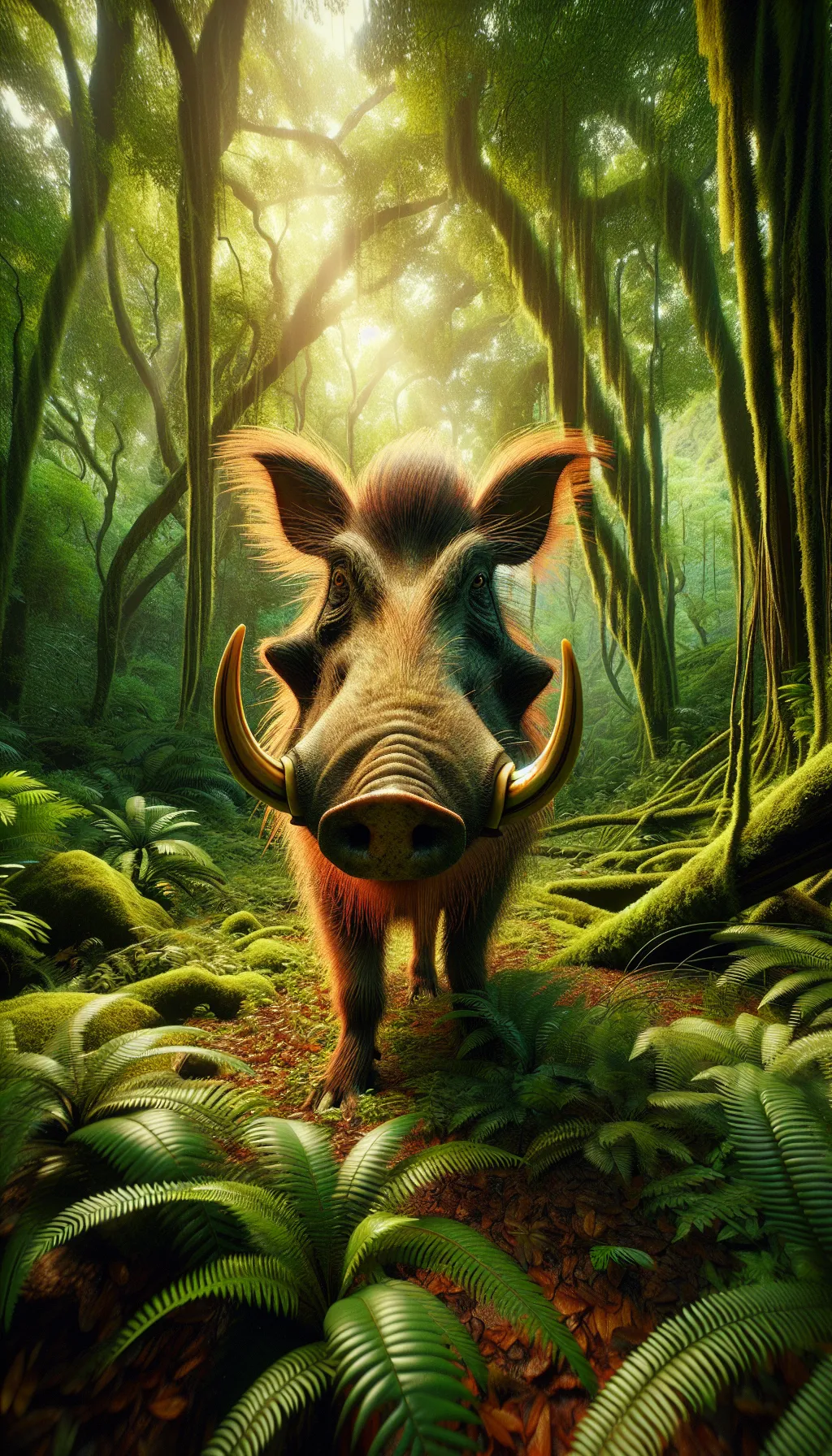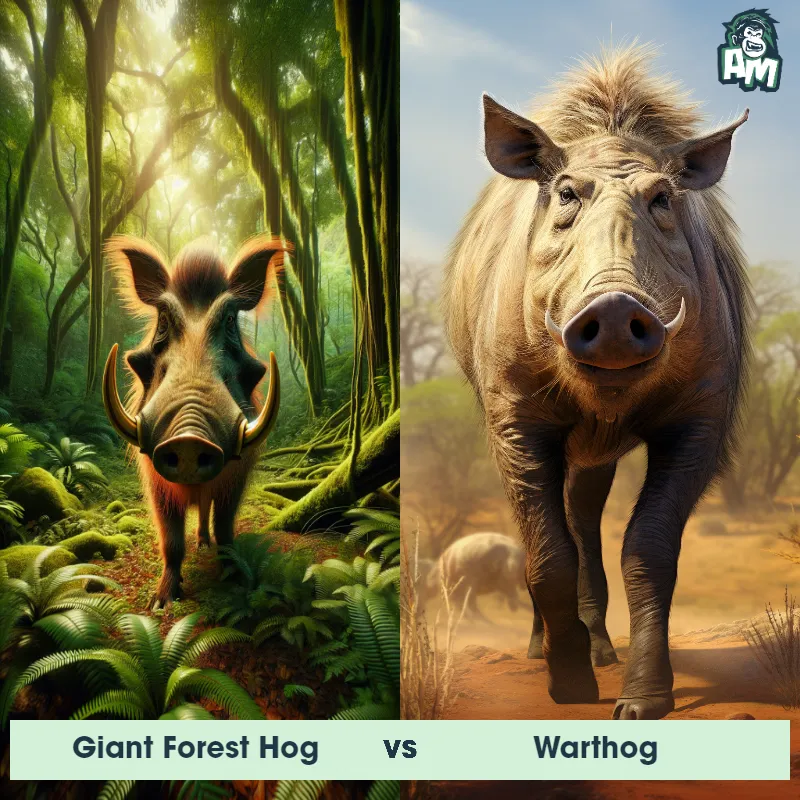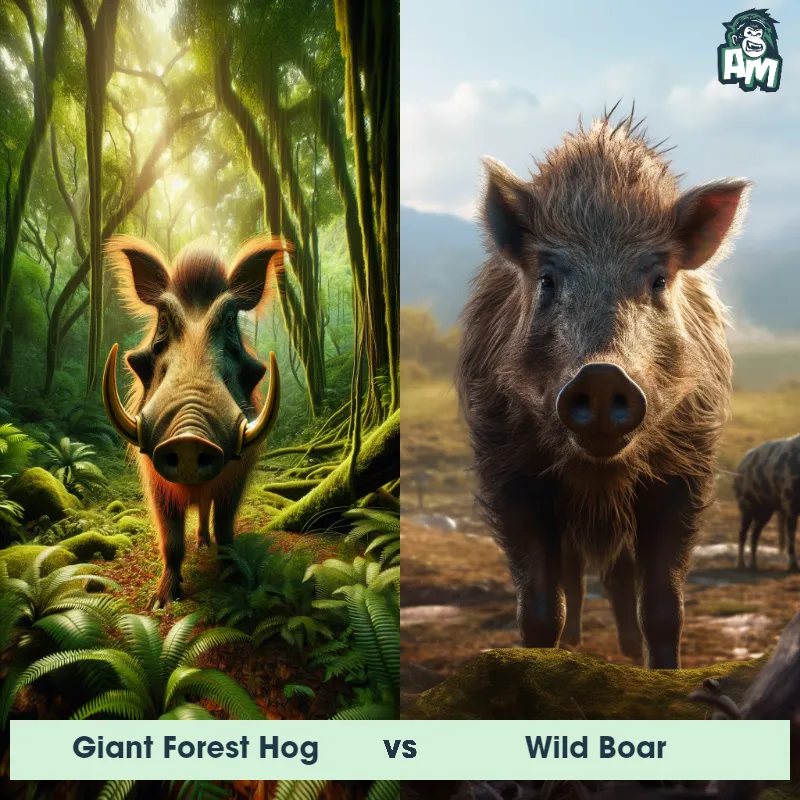The Giant Forest Hog
The Giant Forest Hog, also known as the Hylochoerus meinertzhageni, is a large wild pig native to the dense forests of Central and West Africa. It is recognized as the largest wild pig in the world, with males weighing up to 600 pounds and standing at 3 to 4 feet tall at the shoulder. The animal has a stocky build, a prominent hump on its back, and a long, coarse black coat. It is distinguished by its large, curving tusks and broad, flat snout. The Giant Forest Hog is a solitary creature that prefers to inhabit areas with abundant vegetation and water sources.

| Giant Forest Hog | |
|---|---|
| Size | Up to 6 feet (1.8 meters) |
| Weight | Up to 600 pounds (272 kilograms) |
| Speed | 20 mph (32 km/h) |
| Key Strength | Size and powerful tusks |
| Biggest Weakness | Slower speed compared to predators |
| Scientific Name | Hylochoerus meinertzhageni |
| Family | Suidae |
| Habitat | Rainforests |
| Geography | Central and Western Africa |
| Diet | Roots, tubers, fruits, edible plant matter |
| Lifespan | 10 years - 15 years |

The Giant Forest Hog
The Giant Forest Hog, also known as the Hylochoerus meinertzhageni, is a large wild pig native to the dense forests of Central and West Africa. It is recognized as the largest wild pig in the world, with males weighing up to 600 pounds and standing at 3 to 4 feet tall at the shoulder. The animal has a stocky build, a prominent hump on its back, and a long, coarse black coat. It is distinguished by its large, curving tusks and broad, flat snout. The Giant Forest Hog is a solitary creature that prefers to inhabit areas with abundant vegetation and water sources.
Fun Fact: Despite their massive size, Giant Forest Hogs have surprisingly agile and nimble movements, allowing them to swiftly navigate through thick forest undergrowth.
| Giant Forest Hog | |
|---|---|
| Size | Up to 6 feet (1.8 meters) |
| Weight | Up to 600 pounds (272 kilograms) |
| Speed | 20 mph (32 km/h) |
| Key Strength | Size and powerful tusks |
| Biggest Weakness | Slower speed compared to predators |
| Scientific Name | Hylochoerus meinertzhageni |
| Family | Suidae |
| Habitat | Rainforests |
| Geography | Central and Western Africa |
| Diet | Roots, tubers, fruits, edible plant matter |
| Lifespan | 10 years - 15 years |
Giant Forest Hog Matchups
We use AI to simulate matchups between the Giant Forest Hog and other animals. Our simulation considers size, strength, and natural predatory behaviors to determine the most likely outcome.

Can't find the Matchup you want?
Create Your Own MatchupGiant Forest Hog: Diet, Predators, Aggression, and Defensive Behaviors
What do Giant Forest Hogs eat?
Giant Forest Hogs are omnivores and have a varied diet. Giant Forest Hog primarily feed on roots, tubers, fruits, and fallen nuts in the forest. However, Giant Forest Hog also consume insects, small mammals, and even carrion when the opportunity arises. Their diet changes depending on the season and availability of food in their habitat.
Do Giant Forest Hogs have any predators?
Yes, Giant Forest Hogs have predators in the wild. Giant Forest Hog are hunted by large carnivores such as lions, leopards, hyenas, and wild dogs. Young hogs may also be targeted by pythons and crocodiles. However, adult hogs are formidable opponents and can defend themselves against most predators.
Are Giant Forest Hogs aggressive?
Giant Forest Hogs are known to be aggressive and territorial animals, especially when threatened or cornered. Giant Forest Hog will charge at intruders or perceived threats with their tusks, which can cause serious injury. It is best to give them space and avoid confrontation if encountered in the wild.
Do Giant Forest Hogs fight?
Giant Forest Hogs are solitary animals and rarely interact with each other outside of mating season. However, when faced with a threat or during territorial disputes, Giant Forest Hog can engage in physical fights. These fights are usually brief and involve tusks clashing and pushing each other with their strong bodies.
How do Giant Forest Hogs defend themselves?
Giant Forest Hogs have several methods to defend themselves against predators. Their most prominent defense mechanism is their large tusks, which can be used to slash or stab attackers. Giant Forest Hog are also agile runners and can quickly escape from danger by darting into the thick undergrowth of the forest.
What is the biggest weakness of Giant Forest Hogs in a fight?
Despite their formidable tusks and aggressive nature, Giant Forest Hogs have a vulnerable underside that is relatively unprotected. If an attacker manages to flip them onto their back, Giant Forest Hog become more susceptible to injuries. Predators like lions and hyenas often target this vulnerable area during attacks.
Fun Fact: Giant Forest Hogs are adept swimmers and have been observed crossing rivers and streams without much difficulty, using their powerful legs and buoyant bodies.
Fun Fact: These intelligent animals have a keen sense of smell and are capable of locating underground tubers using their snouts, allowing them to dig up and enjoy this nutrient-rich food source.













